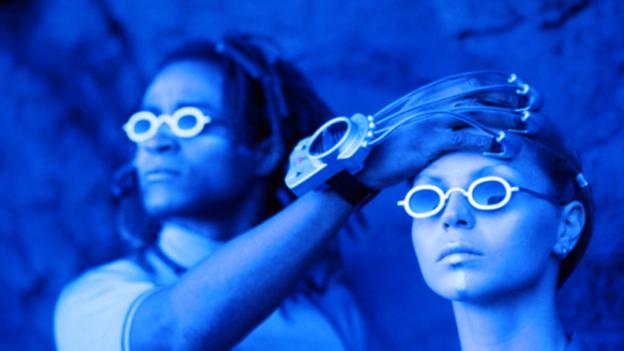
There’s tantalising confirmation that engineering would one be able to day permit us to transmit musings telepathically between two brains. The inquiry is the means by which far would we be able to go?
In a lab at Harvard Medical School, a man is utilizing his brain to wag a rodent’s tail. To send his order, he just looks at a strobe light gleaming on a workstation screen, and a set of cathodes adhered to his scalp discovers the movement triggered in his cerebrum. A PC methodologies and transfers the terminals’ indicator to a ultrasound machine balanced over the rodent’s head. The machine conveys a train of level vigor ultrasound beats into the rodent’s mind, invigorating its engine cortex – the range that legislates its developments. The beats are pointed deliberately at a rice-grain estimated territory that controls the rodent’s tail. It begins to wag.
This connection up is the brainchild of Seung-Schik Yoo, and it works more than 94% of the time. Whenever a human checks out the glinting lights, the rodent’s tail generally dependably begins to wag a little more than a second later. The association between them is verifiably modest. The volunteer is fundamentally flicking a switch in the rodent’s mind between two positions – move tail, and don’t move tail. Anyway it is still a breathtaking early case of something we will see a greater amount of in impending years – a path to unite between two living brains.
Science-fiction is full of comparable (if more ostentatious) mind to mind connects. From the Jedi knights of Star Wars to different characters in the X-Men funnies, prominent society flourishes with telepathic characters that can read minds and transmit their considerations without any straight physical contact or the utilization of their faculties. There’s no proof that any of us insignificant mortals impart the same capacity, however as Yoo’s study shows, engineering is edging us closer in that heading. The inquiry is: the way far would we be able to reproduce telepathy utilizing gadgets? A human wagging a rodent’s tail is one thing. Will we ever come to the heart of the matter where we can offer discourse or feelings or remembrances?
The primary step might be to translate what somebody is supposing. Neuroscientists have made significant advancement in decoding pictures from examples of cerebrum action, and numerous aggregations are finalizing translating inward discourse. Individuals have devised a workable plan to appropriate machine cursors, manufactured appendages and virtual automatons through cerebrum workstation interfaces (BCI), which utilize cerebrum action to control man-made mechanisms. However to accomplish correct telepathy, mind movement must be decoded and used to impact an additional cerebrum. “We’ve got cerebrum to machine interfaces, yet we require the other side of it – PC to cerebrum interfaces,” states Yoo.
A year ago, Christopher James from the University of Warwick fabricated an exceptionally simple one. He utilized scalp terminals to rationally control a set of LEDs, which flashed at one speed when James considered moving his left hand, and at a different when he envisioned moving his right hand. James’ little girl was viewing the LEDs, and however she can’t intentionally recognize between the two blazing speeds, her image cortex – the part of the mind that methodologies sights – enrolled the distinction. By measuring the movement in her mind, an additional set of anodes could work out what the LEDs were doing.
This may have been an electronic connection up between two human brains, yet as James focuses out, its not telepathy. “It’s not prefer somebody sits there picturing a mind boggling contemplation, and it shows up in the other individual’s head,” he states. “My girl was totally unconscious. At no focus did she state “Left” or ‘Right’. It might have been more enlightening to put the expressions on the screen.” She too needed to take a gander at the LEDs to enroll what was incident, which maltreats the “no faculties permitted” control of accurate telepathy.
Brain dictionary
Yoo’s study, joining a human to a rodent, was closer. Miguel Nicolelis from Duke University gave an additional striking illustration prior not long from now, by uniting the brains of two rats that were confronted with the same undertaking –press one of two levers to get a compensating drink. The point when the first rodent settled on its decision, electrical movement in its engine cortex was recorded and changed over into a less troublesome indicator – either one electrical beat or a train of them, relying on which lever it pressed. The signs were channeled to a different embed in the engine cortex of the second rodent, which had its particular levers. Provided that it picked the same one as its nameless accomplice – which it did 64% of the time – both rats got an additional beverage. Coincidentally, one rodent was in the US city of Durham, North Carolina, while the other was in Natal, Brazil.
The aforementioned illustrations are mind blowing, yet every last one of them included the transmission of extremely basic informative data – nothing more perplexing than a double decision. Left or right. One or zero. The telepathy of science-fiction is still looking all in all fictional.
What might it take to send a more intricate note? A sensation? A memory? We know its surely plausible to inspire vivid sensations by fortifying diverse parts of the mind. Focus on the retina or the image centres and you can prepare deceptive flashes of light called phosphenes. Besides in the 1950’s, neurosurgeon Wilder Penfield broadly evoked vivid colours, sounds and remembrances by empowering distinctive parts of a surgical patient’s mind.
However to do this in a correct, focused on path is significantly more challenging. Simply recognize offering something modest like the feel of an entryway. “You feel a ton of diverse sensations like temperature and texture, and different territories of the mind tend to be locked in to decipher what’s going ahead. You need to unravel the sum of that” states Yoo.
Right away, ponder opening the entryway. “You need to make the choice to open the entryway, realize what an entryway is and looks like, recognize a handle, realize that the handle goes down, and train your arm to move” states James. At the minute, our cerebrum PC interfaces can just adapt to the final touch. Researchers have in fact utilized electrical embeds to join the engine cortex with muscles in an arm, permitting patients to move elsewise paralysed appendages. Be that as it may whatever remains of the steps enlisted person numerous more parts of the cerebrum included in memory, dialect, choice making, and that’s only the tip of the iceberg.
To aggravate matters, the greater part of this will differ from single to single person. The neurons in my mind that encode the notion of an entryway may dwell in the same general zone as their partners in your mind, however not in precisely the same spot. To adequately translate complex content from one cerebrum and encode it in an alternate one, you’d need to assemble an intensive “concordance” for every mind, interfacing neural movement over the entire light black blob with diverse ideas or sensations. “We need to independently customise it all,” states Yoo.
There are innovative challenges as well. Specialists like James and Yoo have depended on electroencephalography (EEG) – a strategy that uses cathodes positioned on the scalp to measure underlying cerebrum movement. On the in addition to side, its straightforward to utilize and doesn’t use surgery. Lamentably, James contrasts it with “recording 150 discussions in a stuffed assembly hall while you’re sitting outside with 50 receivers.”
Drill deeper
Invigorating the cerebrum from the outside is uniformly unrefined. Researchers are restricted to methods like transcranial magnetic stimulation, which utilize attractive fields to zap impressive regions of the cerebrum into fervor or resignation. Besides Yoo’s system – centered ultrasound – is fresher, however still includes immobilising a rodent’s head under a vast machine. None, of these system is generally suited for conveying exact sensations.
The best elective is to truly bore through the skull and embed anodes. The aforementioned have enhanced to the focus where we can record movement from a modest, tight bunch of neurons and fortify them with quick and cautious timing. Be that as it may you might need to mortar the entire cerebrum with them. Furthermore did I specify the penetrating? “Is it something that people without intense medicinal issues may as well endure?” asks Michael D’Zmura, a therapist from University of California, Irvine. “I suppose not.”
All of which raises the discriminating inquiry: why might you inconvenience? “You need to contrast the aforementioned alternatives with what we’re fit for when we address each one in turn“, states D’Zmura. We as of recently have unfathomably advanced natural equipment for making and translating resonances, which don’t depend on any inserts or surgeries.
That stated, every living soul says the conceivability of corresponding with bolted in patients, who are completely astir and cognizant however unable to move or talk. In any case it is difficult to see what profit a verifiably telepathic association might give past what less difficult mind PC interfaces could realize. The aforementioned machines have as of recently permitted bolted in patients to control artificial limbs or send messages to their loved ones, and since the aforementioned individuals are conscious, getting messages to them is not the issue.
So the perfect of imparting complex qualified data may be a red herring. James finds it simpler to visualize scenarios where passing on modest sensations is more of service. “Assuming that you have an occupied air-movement controller whose faculties are everywhere on the spot, you could picture bypassing every one of them and conveying a sort of alarm when two airplane are verging on each other“, he states. It doesn’t must be a clear inform. It could be something as modest as a shivering feeling – less Professor X’s psychic arousing cries, and more Spider-Man’s arachnid sense.
Provided that you might want to remark on this movie or all else you have viewed on Future, head over to my Facebook page or inform me on Twitter.
